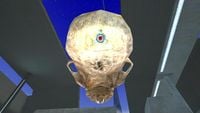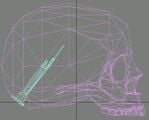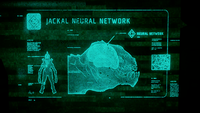Neural interface
From Halopedia, the Halo wiki
The neural interface, commonly known as a neural implant[1] or neural lace,[2] is a type of technology used by both UNSC[3] and Covenant.[4]
Functions[edit]
Human[edit]
The basic function of the standard neural interface is to act as a "friend or foe" indicator, so that radar signatures will pick up the owner's signature and identify it as friendly. This way, the wearer appears as a "yellow" blip on the motion tracker of another soldier's heads-up display and friendly fire is less likely.[3] Additionally, the implant can be used to track and home in on its wearer in the event of capture by enemy forces, for example. While normally detectable under layers of rubble or rock, the signal is no longer reliable several meters underground.[5] More advanced models issued to key personnel possess a number of additional functions, including connections to data networks, enabling the wearer to coordinate with other command personnel as well as AIs and securely access sensitive data.[6] War Games training simulators employ the participants' neural interfaces to provide them with simulated sensory input to make the training scenarios more authentic.[7]
The neural interface is implanted at the base of the skull and can only be removed through sophisticated surgery.[8] The most basic interface, known as a "neural chip", is implanted in all UNSC military personnel upon activation, but it can be replaced with a more specialized neural lace should the need arise.[3] Ship commanders receive command neural interfaces, while the Spartans have received the more specialized "SPARTAN neural interface". The basic neural chip is completely embedded under the skin and possesses no external interface port, unlike the more specialized variations.[Note 1]
Expensive and requiring complicated surgery when first introduced, neural interfaces and their mediating computing systems could be fitted in a simple outpatient clinical procedure by 2557. High-bandwidth interfaces can be paired with advanced expert systems to augment – and even bypass – the human motor system, reducing the physiological stress of high-performance combat exoskeletons to levels that do not require extensive skeletal reinforcement. This innovation, initially a secondary line of research during MJOLNIR’s early days, was crucial for the SPARTAN-III and SPARTAN-IV programs.[9][Note 2]
Finally, neural interfaces are used by vehicle crews to allow them to use their vehicles more effectively. Most notable example of this is the Scorpion tank, where a neural interface allows a single crewman to effectively control every function of the tank, rather than requiring a standard crew of a driver, gunner, and commander.[10] As standard issue neural interface chips used by infantry and starship crews lack an external port, it is likely that vehicle crews are issued with different neural interface chips which feature an external port.
Covenant and its remnants[edit]
Covenant strikecraft pilots connect to their flight systems using direct neural interfaces, which employ very minimal safety cutouts or filters. The pilot's body is rendered immobile to prevent self-injury and agony is inflicted in exchange for superior control of the ship. The Sangheili enter battle-meditation before completing the machine link protocols to control the pain, while Jiralhanae pilots embrace the interface burn to trigger their own focus.[4] In addition, the Sangheili-developed Flight harness also features a hyper-wave link for cleaner craft interactions and a mouth piece that retains a multi-port for use with older Keljiric-pattern Tarasques and N'weo-pattern Gigass. The more compact deltoid armor has less of an impact on the elite's range of motion in the cramped compartments of subluminal space craft and reduces overall fatigue in multi-phase interdiction missions. The less cumbersome cage utilizes aligned composites to postpone the onset of fatigue and the explicit primary environment multi-port is less restrictive than older helmet multi-port.[11]
Trivia[edit]
- The skulls in the Halo games have neural interfaces.
- Some Kig-Yar bounty hunters particularly love to go after heads equipped with neural interfaces when carrying out a mev-ut.[12]
Gallery[edit]
Fleet Admiral Terrence Hood's command neural interface.
The neural interface, as seen on the Oddball in Halo: Combat Evolved.
The Flight harness is a specialized Sangheili harness developed for use with the Tarasque-class heavy fighters and N'weo-pattern Gigass.
A diagram of an Ibie'shan's neural network.
Notes[edit]
- ^ This is evidenced by the fact none of the regular Marine personnel in the Halo games have a visible interface port on the back of their heads.
- ^ It is unclear why the Spartan-IIIs would require the reduction of physiological stress from MJOLNIR armor, since they did receive extensive augmentation to their skeletal structure in the form of the "carbide ceramic ossification" procedure, just as the Spartan-IIs did (Ghosts of Onyx, page 102). Furthermore, it is stated that the Spartan-III enhancements were a "quantum leap" over the Spartan II augmentation set (Ghosts of Onyx, page 63). Coupled with the descriptions of the procedures themselves, Ghosts of Onyx indicates the Spartan-III augmentations were just as potent if not more so than those of their predecessors, so there is no apparent reason why they would require additional safeguards to wear Mjolnir armor.
Sources[edit]
- ^ Halo: Combat Evolved, campaign level The Truth and Reconciliation
- ^ Halo: Combat Evolved, campaign level The Pillar of Autumn
- ^ Jump up to: a b c Halo: The Fall of Reach, page 118
- ^ Jump up to: a b Halo: Warfleet, page 59
- ^ Halo: Mortal Dictata, page 292
- ^ Halo: The Flood, page 57
- ^ Halo Waypoint: Canon Fodder - Beta Late Than Never
- ^ Halo: Glasslands, page 189
- ^ Halo Waypoint: Canon Fodder - Armory Amore
- ^ Halo: Combat Evolved, game manual
- ^ Halo 3, armor description
- ^ Halo: Glasslands, page 218







